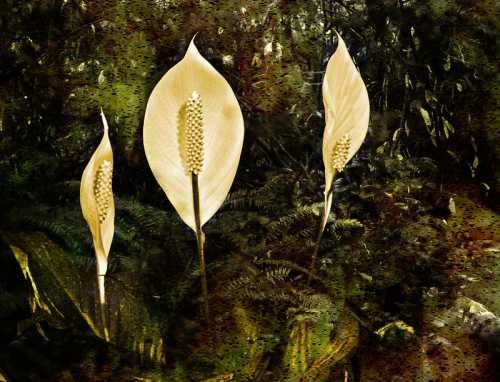Peace lily, otherwise known as closet plants or Spathiphyllum, is a popular plant choice in homes and offices. As an indoor plant, they are easy to take care of and require little attention.
Peace lilies have lush, shiny green leaves and a flower that is hooded by a white leaf; the plant is a delight to look at. They have high aesthetic value and also clean the air of the room they are kept in.
While growing peace lilies is a reasonably easy task, some gardening mishaps can cause them to die or their leaves to turn yellow, brown or black.
Peace Lily Flower Turning Yellow

Is the flower of your race, lily turning yellow? This could be due to some common mistakes like overwatering and some pro mistakes like light issues. So let’s look at the possible causes of peace lily turning yellow.
Healthy peace lily plants have shiny deep-green leaves, lance-shaped flowers, and a white leaf that hoods the sweet-smelling flower. However, some actions can make it unhealthy, leading to discolouration.
Also Read: How Much Sunlight Does Peace Lily Need?
#1 Overwatering
One common reason for yellow leaves of peace lily can be overwatering. On average, a peace lily needs to be watered every 7-10 days.
However, water intake can be monitored from time to time by checking the soil; if it seems dry, water the plant; if not, then don’t. Overwatering one’s plant can lead to waterlogging, preventing a plant’s root from absorbing and transporting water, thus essentially killing them.
Water your peace lily once a week and always check the soil for dampness before watering.
#2 Underwatering
Not only overwatering but underwatering your peace lily can also cause the leaves to turn yellow. When the soil dries out, the plants do not get sufficient water to do photosynthesis and thus start to wilt.
Chronic underwatering can result in weak, yellow and discoloured leaves. Check the dampness of the soil and create a regular schedule for watering your plants.
Water your plants moderately and keep a close eye on them to understand their needs. Let the soil mix become dry but not too dry, and then water it.
#3 Excess minerals
An excessive presence of minerals in the soil can also be a cause of yellow leaves. For example, if you use water from a water softener, there are chances that it has too many minerals in it.
In such a case, prune off the yellow leaves and flush the soil with bottled or filtered water as this water has far fewer minerals. Then, if the problem continues, you can repot the peace lily in fresh soil.
Constantly water your peace lily with filtered, bottled or rainwater to prevent the build-up of excess minerals. Also, do not overwater.
Also Read: Do Marigolds Keep Snakes Away?
#4 High Chemical content
High chemical presence in water can cause yellow leaves. Chemicals like chlorine and fluoride, when abundant in water given to plants, can lead to discolouration.
If you use tap water, let it sit for a while so that chlorine may be off-gas; however, this will not eliminate fluoride. The best option is to stick to bottled, filtered and rainwater for your plants.
#5 Ageing
As plants grow in age, their leaves naturally start to turn yellow, brown, discoloured and die. With age, plant leaves become weak and discoloured.
If your peace lily is old, prune off its lower yellow leaves and not stress it. Use a sharp tool to shear them off as blunt blades can cause damage and infections in plants.
Natural ageing cannot be reversed or improved on, so prune your leaves.
#6 Too much light
Indoor plants like peace lily can thrive indoors because they do not need too much light or water. However, too much or harsh sunlight can cause yellow leaves.
You can check if too much light is the cause of yellow leaves by looking at the veins. When the problem is light, the leaves turn yellow, but veins stay green.
Peace lilies need low-to-medium light and thus suffer when given too much light. Avoid bright, direct sunlight or fluorescent light. Light fluorescent light is enough for peace lilies.
#7 Cold air
Freezing temperatures can damage peace lilies. Peace lilies thrive in temperatures from the 65-85 degrees Fahrenheit range. However, temperatures below 45 degrees Fahrenheit can cause damage and yellowing of leaves.
Please do not keep your peace lily out when it starts to get too cold. Instead, keep the plant in even and chill-free temperatures.
#8 Hunger
Lack of nutrients in the soil or water can cause yellowing leaves as they leave the plant hungry. Also, a lack of minerals such as iron or magnesium can cause yellow leaves as they must stay green.
Fertilise your peace lily once or twice a year to ensure that the mineral content is adequate. Remember, too much or too little of anything is harmful.
Use a high-quality potting mix that is high in organic mineral levels. Yellow leaves do not turn green again except when low mineral leaves cause yellowing, so don’t worry there’s still hope.
#9 Pests
Pests like spider mite, heavy mealybug or aphid infestation are unhealthy for peace lilies and turn their leaves yellow. Therefore, it is uncommon for healthy peace lilies to be infested by them.
It is most likely that pests grew simultaneously with another problem: overwatering, poor placement, etc. They get rid of pests by washing or wiping them; if they persist, use neem oil insecticide.
#10 Diseases
Funguses or parasites can turn a peace lily’s foliage yellow. They can be prevented by taking good care of the plant; however, throwing away your plant is the best option if they show up.
Peace lily flower turning brown
Peace lilies are beautiful plants that can be easily maintained; however, if you see the leaves turning green, it is time to review your plant care steps.
A healthy peace lily has lush, green leaves and white flowers hoods by a resplendent white leaf. Brown leaves are a sign that there are some issues. Reasons for brown leaves
Water problems
Overwatering or underwatering are the most common reasons for brown leaves. Too much water will cause waterlogging, and underwatering will wilt the plant.
Irrigation problems can be avoided by keeping a regular water schedule and keeping a check on the dampness of the soil.
Also Read: How Long Can a Peace Lily Go Without Water?
Humidity
Peace lilies thrive in warm, wet climates, and thus humidity is necessary for them. A lack of moisture can be the reason for its foliage turning brown.
You can counter this by putting pebbles in a large saucer to trap moisture. This is especially important if you live in dry areas.
Fertiliser
Excessive use of fertiliser is another cause of brown leaves. Peace lilies do not need much fertiliser. A few times a year is enough. However, excessive fertiliser will increase the mineral content and lead to brownness.
Salt
Similar to fertiliser, high salt content will also spoil a peace lily’s leaves. If you feel that the water is high in salt content, use bottled or filtered water.
Also Read: How to Revive a Dying Pothos Plant?
Why peace lily flower turning black?
Black discolouration on the leaves of a peace lily can be due to three main reasons, namely-
Too much or too little water
When too much or too little water is given to the peace lily, its leaves turn yellow, then brown and finally black. Therefore, checking the issue and rectifying it by adequately watering the plant is best.
Spruce off the black leaves and watering habits.
Temperature change
An extreme temperature exposure, whether too high or too low, will cause discolouration that gets black. So keep your peace lily indoors and maintain an even temperature.
Fungal infection
Fungal infection called Phytophthora or aerial blight turns the foliage black. To prevent its spread, you will need to keep water far from the leaves.
You may also need to treat both the soil and the leaves with a fungicide, preferably an organic one. This could be cumbersome so if you are a novice, consider getting a new plant.
The Bloom
Apart from the foliage turning black, another unhealthy situation is which the spadix or the spike-shaped white flower turns black. This protrusion is known as bloom and has minute flowers in it.
The bloom may also turn black, and its cause will depend on its age. If the bloom is a few weeks old and gets black, it shows that the bloom is in decline, a natural process in peace lilies.
You can check if the bloom is declining by looking at the leaves; if they seem green and healthy, then there’s no issue. Next, get rid of the wilted bloom by cutting it off.
If the bloom is very fresh and blackening, then it is a sign of stress. If your leaves also show discolouration, there are chances that you are overwatering the plant. Check on the soil before watering.
Also Read: Does Swiss Chard Grow Back After Cutting?
Tips for maintaining your peace lily
Here are some tips that will make it easy for you to take care of your peace lily-
- Have a watering schedule
- Always check the dampness of the soil before watering
- Do not overwater or underwater
- Keep away from harsh light
- Peace lilies do not enjoy low temperatures
- Maintain an even temperature within the house
- Fertilise the plant 2-3 times a year
- Do not over-fertilise
- Use bottled or filtered to water them
- Water high in floured, chlorine and salt is not suitable for them
- Wipe leaves with soapy water regularly to prevent pests
- Wipe leaves with soapy water
- Try to keep moisture trapped for them
Conclusion
Peace lilies are house plants that can be quickly taken care of. However, some unhealthy practices can cause the leaves to turn yellow, brown or black.
Actions such as overwatering, underwatering, over-fertilisation, excessive light, high salt content, fluoride, chlorine, fungal infections etc., can damage the peace lilies. Another inevitable cause is ageing.
Take good care of your peace lily by following the steps mentioned above.
